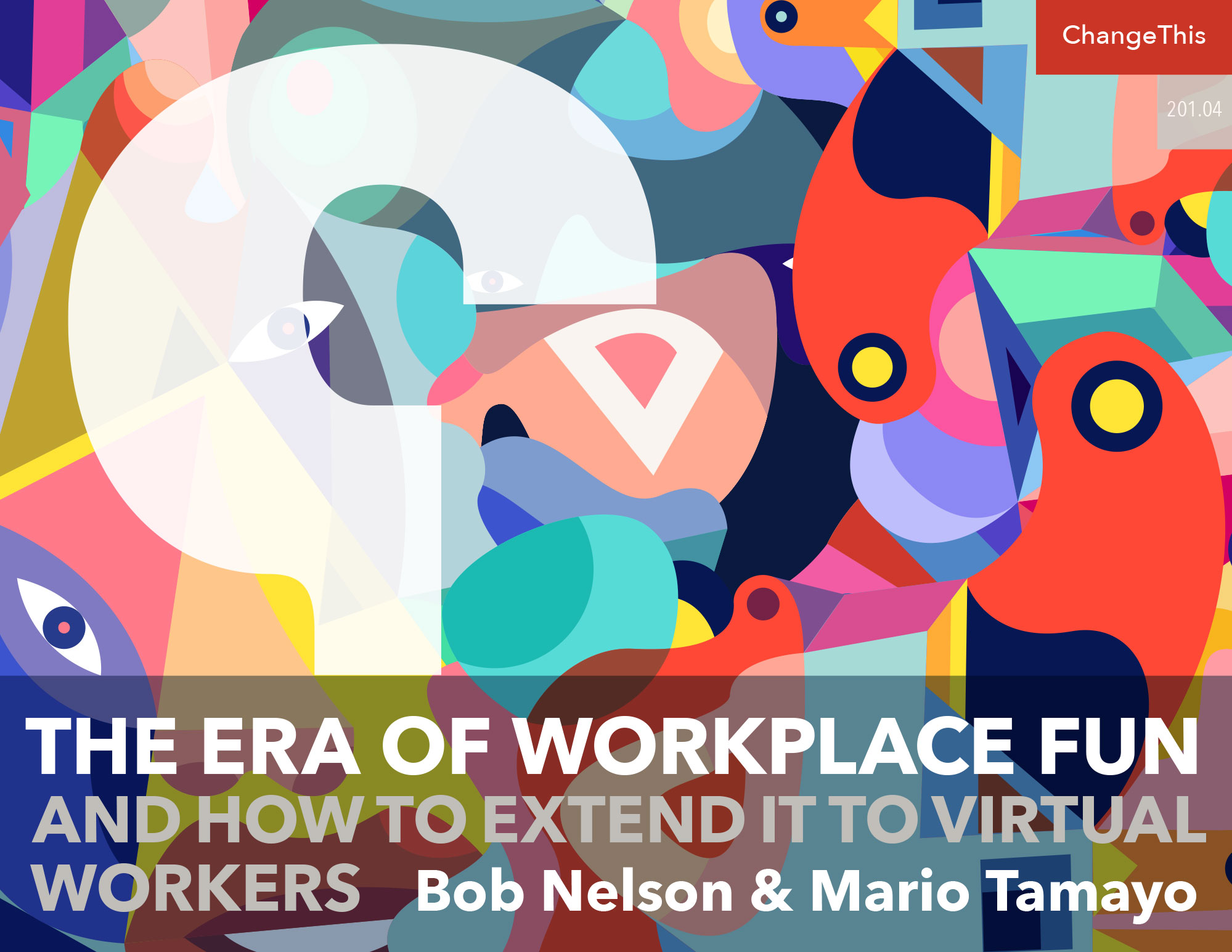The Era of Workplace Fun (And How to Extend It to Virtual Workers)
“Work” and “fun” have historically been considered polar opposites of each other—it was thought that you can work or you can have fun, but you can’t do both at the same time—or in the same place.
Work is what you do for your paycheck, and fun is what you do on the weekend. Most of us must work to earn money to live, and sometimes enjoying the work we do seems like a luxury we can’t afford. Or can we?
For individuals, time at work goes by faster as they become more excited about their work, who they work with, and what they are achieving, which all affect the pride they have in their work, themselves, and the company. The benefits to companies are also substantial, as promoting a fun work environment helps them become an “Employer of Choice,” which makes it easier to attract high-performing talent because such talent better enjoy their work and, as a result, stay with the organization longer.
Each year, the Great Place to Work Institute asks thousands of employees to rate their experience of workplace factors, including “This is a fun place to work.” On Fortune’s “100 Best Companies to Work For” list, employees in companies that are ranked as “great” responded overwhelmingly—an average of 81 percent—that they are working in a “fun” environment. The big takeaway: Employees at the best companies are having the most fun. In other words, high performers are having the most fun. And people who are having fun tend to be high performers. It’s two sides of the same coin.
At the “good” companies—those that apply for inclusion but do not make the top 100— only 62 percent of employees say they are having fun. That gap in experience between the great and good companies is, surprisingly, one of the largest in the survey.
This is compelling data that supports the notion that any company should strive to make work more fun for employees in their organization.
So why don’t more people have fun at work? Is it our puritan work ethic that makes us feel guilty if we are having fun? Is it our fear of being judged, ridiculed, or chastised by others—especially our boss? Do we inherently feel that doing fun things is “wasting time” when we could be, and are being paid to be, productive? Maybe we each harbor a little of all those concerns.
The reasons we don’t have more fun at work are many. But we all do have a choice in the matter
EVEN VIRTUAL WORK CAN BE FUN
No part of work has changed more than the recent movement to work from home, driven by the worldwide coronavirus pandemic.
Most every worker who could work from home was asked to do so, and employees and companies did the best they could to adjust to the new circumstances. Even before the pandemic, however, there was a drastic shift toward employees working remotely. An analysis done by FlexJobs and Global Workplace Analytics found that in the five years prior, the number of employees working remotely increased 159 percent. International Workplace Group found 80 percent of U.S. workers say they would turn down a job that didn’t offer flexible working, and more than a third said they would prioritize such arrangements over having a more prestigious role. In Crain’s Future of Work survey, more than three-fourths of respondents cited flexible schedules and remote work as the most effective nonmonetary ways to retain employees.
How does working virtually affect employees’ fun and happiness? A study of 1,001 remote workers by Amerisleep found that they are 57 percent more likely than the average American to be satisfied with their job, plus, nearly 80 percent of respondents described their typical stress level during the workweek as either “not stressed” or only “moderately stressed.” And another study by Owl Labs found that people who work remotely at least once a month are 24 percent more likely to be happy and productive.
Many organizations are finding creative ways to deliver fun experiences to their remote workers. And your efforts can go beyond popular videoconferencing platforms and apps such as Zoom, Webex, Google Meet, Slack, BuzzFeed, Houseparty, and so on.
During the pandemic Bob’s wife Jennifer tuned into a short weekly “dance party” at 2 p.m. on Fridays on Instagram. “It’s high-energy and fun—the perfect pick-me-up to end the week!” she said.
GitLab, a web-based repository management company from San Francisco, California, encourages its remote employees to spend a few hours every week taking coffee breaks together through a video call.
Education company General Assembly, headquartered in New York City, hosts a video chat room for workers to join in the morning for watercooler chat over coffee.
Synlogic Therapeutics, a Cambridge, Massachusetts, biotech, sends pancake-making kits to employees’ homes and asks people to post pictures of their breakfasts. “We had pancakes in all flavors and shapes—from ‘Star Wars’ ships to coronaviruses,” explains CEO Aoife Brennan.
Trello Software, web-based list-making application company based in New York City, offers lunch to its virtual workforce. Each employee can expense up to $25.
“With the COVID-19 life changes, our school had to go to e-learning,” says Laura Schmidt Brady, director of human resources for Marburn Academy in New Albany, Ohio. “I started virtual happy hours for our staff. I invited them to submit topics of conversation like ‘What is the first thing you will do when this crisis is over?’ ‘If you could pick a song or movie title to go with COVID what would it be?’ It’s been fun and engaging. About 20 percent of the staff participate each time which seems perfect for a Google Meet. Folks are appreciative of being able to see faces over the age of 12,” Brady adds.
Deliveringhappiness.com hosts DHCafe, a two-hour weekly meeting for workers to attend and “cwerk.” “It’s not the dirty dance move,” says Sunny Grosso, culture chief, “but a co-work! It’s a casual and fun place to pop in and ask a few questions or connect with the team or even just be on camera while working on something.
There’s magic in the air at Skinceauticals, the New York City–based science-backed skin care brand of L’Oréal, the world’s leading beauty company. With COVID-19 keeping workers at home, general manager Tina Fair came up with something unique to keep people together and things moving in the right direction. Fair brought in a virtual magician for the “happy hour” that kicked off the national sales meeting. “The tricks were amazing and the response so positive, I had to have him do our marketing team meeting,” says Fair. “I loved the ability to be entertained and connect virtually.”
New York City-based Vox Media hosts a daily story time for families, courtesy of its parent employee resource group. CEO Jim Bankoff recently read stories to families.
According to Carol Cochran, the director of people and culture at FlexJobs, a job-search website based in Boulder, Colorado, “if one person works remotely, everyone is working remotely.” Employees participate in regular, virtual non-work gatherings to compete in trivia games, exercise in yoga and belly dancing classes, and celebrate baby showers.
Karen Angeliatta, an Atlanta, Georgia-based consultant and trainer, is a big advocate of Kahoot!, the online tool for educators that turns polling questions into games. “Kahoot! lets us build a Word Cloud from answers to a question. We also use Slack to let attendees share articles, photos, joint activities, etc.,” says Angeliatta. “We had concerns working from home, now we will have even more concerns returning to work. We desperately need to lighten things up to overcome the fears and tensions everyone has.”
Employees at Tripwire, based in Portland, Oregon, hosted a virtual happy hour via Webex with the customer experience team that turned into a game of Pictionary.
The Product Development Electrification Engineering Division of Ford Motor Company invited its employees and their families to participate in an online talent show, to be held before an all-hands meeting. The closing act, an employee heavy metal rock band, wrote and performed their own song, which “brought down the house.” Chief engineer Brett Hinds said, “The concert was a huge success and we received a lot of positive feedback.”
Windy City Fieldhouse, a Chicago, Illinois, corporate event provider, specializes in virtual scavenger hunts. Employees form teams to hunt and compete for points. The company also provides virtual pub trivia, complete with a virtual emcee and team breakout rooms.
The culture committee at FitSmallBusiness, a New York City-based resource company for small businesses, creates and facilitates engagement events and employs a “people experience specialist,” a role filled by Tsion McNichols. “We hold events at times that are comfortable for our people in different time zones,” says McNichols. They play games that translate well over video calls, like bingo, spelling bees, and Pictionary.
At a recent happy hour at Las Vegas, Nevada, online retailer Zappos, the company’s artist in residence created an art project for interested employees. “We sent out a materials list ahead of time—just a few simple things that anyone could find around their home—and during happy hour he taught us a really cool technique for making shadow puppets with paper and string,” said Krissee Chasseur, brand aura research and development lead. “We asked everyone who was crafting along with us to activate their cameras and mics so people could follow along with their work.”
Lansing, Michigan-headquartered Liquid Web, an online hosting company, asks employees to complete a questionnaire about their interests and personality. They are then matched with an employee from a different location. The two swap questionnaires, and based on the other person’s answers, they paint or draw a small 4×4 piece of art for their new friend.
NPR reported that at least one example of videoconferencing “artwork” has gone viral. A company manager tried to set a background filter on her Zoom meeting, and it turned her into a picture of a potato. She didn’t know how to fix it, so she spent the whole meeting as the “potato boss.” She was a great sport about it and the perfect example of how making room for humor in a remote work environment lifted spirits and moved the whole team forward.
San Diego, California-based 2Connect, a globally recognized presentation coaching and training firm, invites their employees and independent contractors to participate in online artwork and poetry happy hours, with a twist. Prior to the artwork party, each person picks a famous painting, sculpture, drawing, or photo. Then they each create their own versions of them, using any online or household items, including themselves. At the party, each one shares their new masterpiece. Prior to the poetry party, the firm selects a topic or subject and asks each person to write and send in two individual lines of prose. Then the entire list of lines is sent to everyone so they can put the lines together in any order to form a complete poem, which is recited at the party. “Finding ourselves instantly virtual because of COVID-19 gave us the chance to connect more frequently, so I wanted to take advantage of that,” says Diane West, 2Connect founder and president. “We could check in on each other, potentially create a fun distraction from our day-to-day stresses, and tap into the creative brilliance of the team. Of course, all of the activities are voluntary, but the engagement has been tremendous. We look forward to continuing these well beyond the virus.”
March, a software company based in Cambridge, Massachusetts, created a job called “remote work and inclusion manager” to ensure remote workers have a high quality of work life.
Workers at Irvine, California-based SecureAuth Corporation, a global identity security firm, take daily five-minute music breaks on Zoom. They get recurring calendar requests and reminders. They sign up to share a song; some have their children and families perform. Others play a meaningful song on Spotify. The leader in Buenos Aires set up a Slack channel for his team. “So far we’ve heard songs popular to our country in certain decades,” says Nichole Devolites, senior manager of customer experience and advocacy. “We had one employee perform a song he wrote with an acoustic guitar; another employee’s family sang with one of the daughters playing the ukulele, and another employee’s 13-year-old daughter played Chopin on the piano.”
One Friday a month, the customer support team at Zapier, the San Francisco, Californiabased app-connecting software firm, hosts a virtual dance party. The team selects a song from Spotify and asks employees to open Photo Booth to record a five-second video of their dance moves. Employees then upload the clip to GIPHY to convert it to a GIF. Finally, the team makes and posts a montage of it on Zapier’s company-wide Slack channel. Incubeta, the marketing service company headquartered in Cape Town, South Africa, does something similar using Google Hangouts.
After going into COVID-19 lockdown, Los Angeles, California-based author Libby Gill created an online “writing sprint” group to replace meeting in her favorite coffee shop. “It’s fun, interactive, and has a similar vibe to our real coffee shop,” says Gill. They give each other feedback and their time is often spent as a focus group—on titles, word choice, content direction, and so on. “I’ve gotten such a great response from my beta group (three months along and still going strong), that I’ve decided to launch more groups.”
FUN WORK IS CONTAGIOUS
Ultimately, fun works best when it is openly encouraged throughout the organization and becomes an expected and anticipated part of everyone’s role and experience at work. This doesn’t tend to happen by accident, but rather from a systematic application and appreciation of the topic by a significant portion of its members.
Ideally, top management would encourage and support fun in the work environment, even participating in the process. But creating a fun-oriented organization does not have to be dependent solely on its senior leaders. Fun at work starts with every individual, initially in how they think about the topic and then in how they apply fun to their everyday work tasks, responsibilities, and interactions with others at work. If you want your work to be more fun, you need to make that a priority and have a playful, funoriented attitude about the topic, look for opportunities, and seek to embed fun in different ways in your daily work activities. By taking responsibility for your own fun at work, you will quickly attract and encourage other like-minded coworkers, which will make it easier to have even more fun!
You might be wondering, “What if I have a boss who’s not very fun?” Well, you can still strive to make your own work fun, but you can also be the person who helps to interject fun into the work environment for others to enjoy, and maybe work on getting your boss to want more fun too!
Fun can’t be forced on others. No one should be made to participate in an activity deemed “fun” by others if they don’t want to. But the more you do it, the more fun at work starts to snowball. Having fun at one task or responsibility will spill over into other tasks and responsibilities that make them more fun. It will also positively affect those around you so that they better enjoy working with you and come to want more fun at work as well.
You can easily choose to make work fun, get better at doing so, and help create a fun work environment for yourself and others you work with. As a result, you’ll find that you’ll tend to enjoy your work more, excel at it more easily, and complete it faster, and you’ll be more likely to advance in your career.
You’ll also find that fun work is contagious—others will want to join in working with you and maybe just take a little of that positive energy and excitement back with them to their own job and work.
Adapted from Work Made Fun Gets Done.
Copyright ©2021 by Bob Nelson and Mario Tamayo.
Published by Berrett-Koehler Publishers, Inc.
ABOUT THE AUTHORS
Bob Nelson, PhD, president of Nelson Motivation Inc., is considered the leading authority on employee recognition and engagement worldwide and has worked with 80 percent of the Fortune 500 companies. He’s a senior fellow for the Conference Board and a top thought leader for the Best Practice Institute and was named a top five management guru by Global Gurus.
Mario Tamayo, a principal with Tamayo Group Inc., has more than thirty years of experience in maximizing human performance, working with companies such as Genentech, Amylin Pharmaceuticals, Petco, and General Dynamics.












































